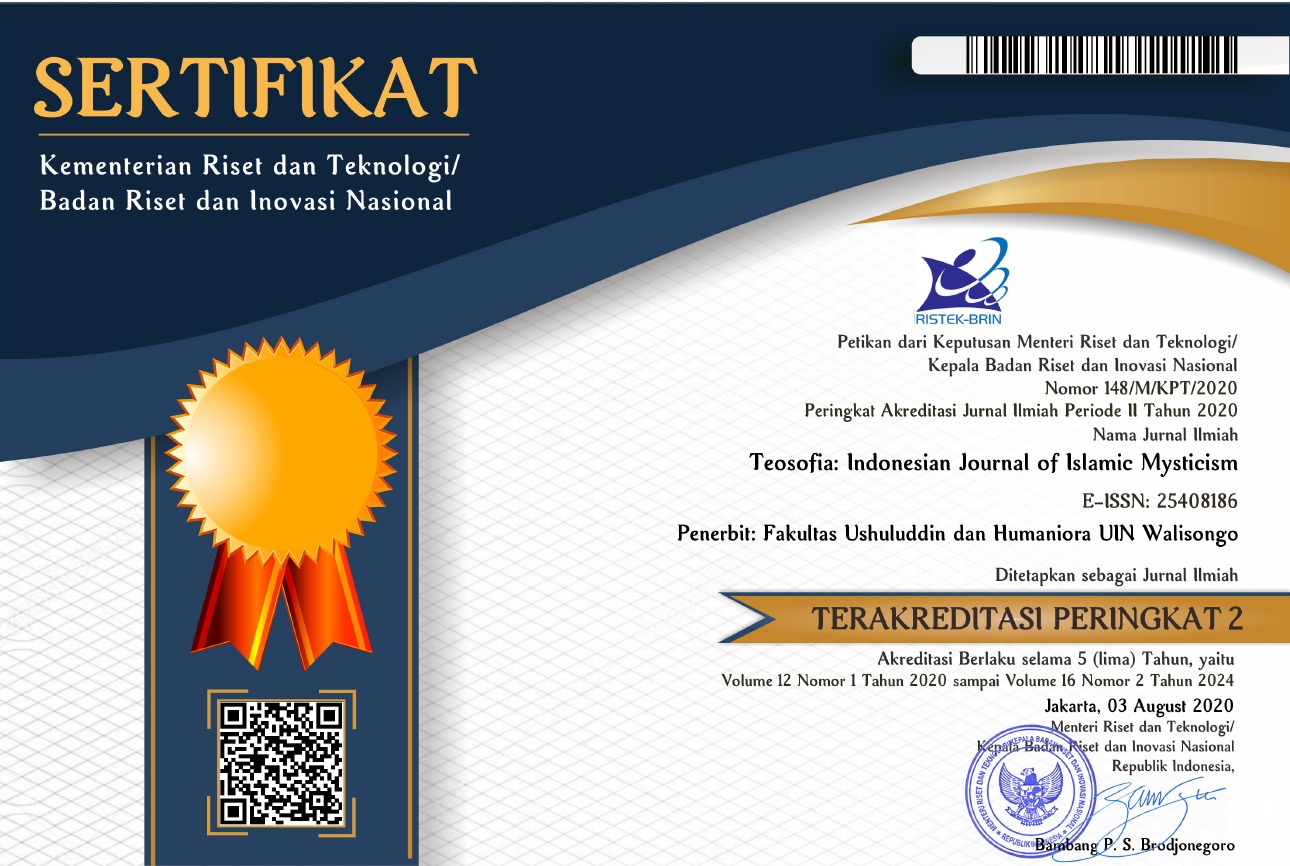Ḥamzah Fanṣūrī’s Contextual Analogies: Wujūdiyya Teaching in Malay 16th Century
DOI:
https://doi.org/10.21580/tos.v11i1.11243Keywords:
analogy, Malay, Ḥamzah Fanșūrī, wujūd, wujūdiyyaAbstract
Abstract: This article aims to analyse the context of the analogies used by Ḥamzah Fanșūrī in teaching wujūdiyya doctrine in his work, Asrār al-‘Ārifīn. The importance of this study is to reveal how he easily taught complex metaphysical concepts in Sufism. He used objects easily recognised by the Malay community as analogies. This article is a literature study using an analytical-descriptive approach. This study found that the metaphors used by Ḥamzah Fanșūrī in teaching the relationship between singularity and plurality in ujūdiyya doctrine were clay and earthen vessels, sun and its light, wood and chess pieces, and sea and wave. In comparison, secondary analogies such as fruit, seeds, mirrors, people, rivers, stones, and iron were used to explain the various dimensions of wujūdiyya teachings. His approach is therefore easy to understand.
Contribution: This article opens a new perspective in understanding Sufism, especially the wujūdiyya doctrine in Ḥamzah Fanșūrī’s teaching. The analogies used are easy to understand. The analogy proposed by Ḥamzah Fanșūrī can be used as a reference to reveal the metaphors used by other Sufis in teaching wujūdiyya.
Downloads
References
Al-Attas, Syed Muhammad Naquib. The Mysticism of Hamzah Fansuri. Kuala Lumpur: University of Malaya Press, 1970.
Asba, Rasyid. Kopra Makassar: Perebutan Pusat Dan Daerah. Jakarta: Yayasan Obor Indonesia, 2007.
Azhari, Ichwan. “Kapur dari Barus: Islam dan Jaringan Perdagangan Kuno.” Medan, 2019.
Azra, Azyumardi. Jaringan Ulama: Timur Tengah dan Kepulauan Nusantara Abad XVII & XVIII. Jakarta: Kencana, 2013.
Badaruddin, Faudzinaim. “Tuhfah al-Mursalah ila Ruh al-Nabiy as the Source of the Doctrine Seven Grades of Being in the Malay-Indonesian Archipelago.” Teosofia: Indonesian Journal of Islamic Mysticism 10, no. 1 (April 2021): 59–74. https://doi.org/10.21580/tos.v10i1.8580.
Baskara, Benny. Islam Bajo: Agama Orang Laut. Pamulang: Javanica, 2016.
Braginsky, Vladimir. Satukan Hangat dan Dingin: Kehidupan Hamzah Fansuri Pemikir dan Penyair Sufi Melayu. Kuala Lumpur: Dewan Bahasa dan Pustaka, 2003.
Bustamam-Ahmad, Kamaruzzaman. Kontribusi Charles Taylor, Syed Muhammad Naquib Al-Attas, and Henry Corbin dalam Studi Metafisika & Meta Teori terhadap Islam Nusantara di Indonesia. Banda Aceh: BandarPublishing, 2017.
Chittick, William C. Ibn ’Arabi: Heir to the Prophet. Oxford: Oneworld, 2005.
Cibro, Ramli. Aksiologi Ma’rifat Hamzah Fansuri. Banda Aceh: Pade Books, 2017.
Doorenbos, Johan. De Gefchriften van Hamzah Pansoeri. Leiden: Betteljee & Terpstra, 1933.
Drewes, G.W.J., dan L.F Brakel. The Poems of Ḥamzah Fansûrî. Dordetch: Forish Publication Holland, 1986.
Fansûrî, Hamzah. “Asrâr al-‘Arifîn.” In The Mysticism of Hamzah Fansuri, diedit oleh Syed Muhammad Naquib Al-Attas, 233–96. Kuala Lumpur: University of Malaya Press, 1970.
———. “Syarâb al-Asyiqîn.” In The Mysticism of Hamzah Fansuri, diedit oleh Syed Muhammad Naquib Al-Attas, 329–53. Kuala Lumpur: University of Malaya Press, 1970.
Fathurahman, Oman. Tanbih Al-Masyi: Menyoal Wahdatul Wujud: Kasus Abdurrauf Singkel Di Aceh Abad 17. Bandung: Mizan, 1999.
Guillot, C., dan Ludvik Kalus. Enskripsi Islam Tertua di Indonesia. Jakarta: Gramedia, 2008.
Guillot, Claude, dan Ludvik Kalus. “La stèle funéraire de Hamzah Fansuri.” Archipel 60, no. 4 (2000): 3–24. https://doi.org/10.3406/arch.2000.3577.
Gullot, Claude. Barus: Seribu Tahun yang Lalu. Jakarta: KPG, 2008.
Hadi, Abdul W.M. Tasawuf yang Tertindas: Kajian Hermeunetik Terhadap Karya Hamzah Fansuri. Jakarta: Paramadina, 2001.
Hadi, Amirul. Aceh: Sejarah, Budaya, dan Tradisi. Jakarta: Obor, 2010.
———. “Islam and State in Sumatra: A Study of Seventeenth-Century Aceh.” International Journal of Middle East Studies 39, no. 3 (Agustus 2007): 485–86. https://doi.org/10.1017/S0020743807070717.
———. “The Ṭāj al-Salāṭīn and Acehnese History.” Al-Jami’ah: Journal of Islamic Studies 42, no. 2 (2004): 258–93. https://aljamiah.or.id/index.php/AJIS/article/view/1057.
Hamzuri, dan Tiarma Rita Siregar. Permainan Tradisional Indonesia. Jakarta: Direktorat Permuseuman, 1998.
Hasjmy, A. Bunga Rampai Revolusi Dari Tanah Aceh. Jakarta: Bulan Bintang, 1978.
———. Sejarah Masuk dan Berkembangnya Islam di Indonesia. Medan: Pustaka Al-Ma’arif, 1981.
Irawan, Bambang, Ismail Fahmi Arrauf Nasution, dan Hywel Coleman. “Applying Ibn ʿArabī’s Concept of Tajallī: A Sufi Approach to Environmental Ethics.” Teosofia: Indonesian Journal of Islamic Mysticism 10, no. 1 (22 April 2021): 21–36. https://doi.org/10.21580/tos.v10i1.7204.
Jabir, Muhammad Nur. Wahdah al-Wujûd Ibn ‘Arabî dan Filsafat Wujûd Mulla Sadrâ. Makassar: Chamran Press, 2012.
Johns, A.H. “The Poems of Hamzah Fansuri.” Bijdragen tot de taal-, land- en volkenkunde / Journal of the Humanities and Social Sciences of Southeast Asia 146, no. 2 (1 Januari 1990): 325–31. https://doi.org/10.1163/22134379-90003221.
Lombard, Denys. “Le sultanat d’Atjéh sous Iskandar Muda (1606-1636).” École pratique des hautes études. 4e section, Sciences historiques et philologiques 98, no. 1 (1965): 491–93. https://doi.org/10.3406/ephe.1965.4974.
Lone, Niyaz Ahmad. “The Role and Significance of Taṣawwuf in Modern-Day Crisis.” Teosofia: Indonesian Journal of Islamic Mysticism 11, no. 1 (2022): 83–96. https://doi.org/10.21580/tos.v11i1.12030.
M. Afif Ansori. Tasawuf Falsafi Syaikh Hamzah Fansuri. Yogyakarta: Gelombang Pasang, 2004.
Mawardi. “Reaktualisasi Kerukunan Antar Umat Beragama dalam Kemajemukan Sosial.” Substantia 17, no. April (2015): 55–66. https://jurnal.ar-raniry.ac.id/index.php/substantia/article/view/4108.
Miswari. Wahdat Al-Wujud: Konsep Kesatuan Wujud antara Hamba dan Tuhan Menurut Hamzah Fansuri. Yogyakarta: Basabasi, 2018.
Nasution, Ismail Fahmi Arrauf. “Humanisasi Pendidikan Islam Melalui Antropologi Transendental Hamzah Fansûrî.” Edukasia : Jurnal Penelitian Pendidikan Islam 12, no. 1 (Mei 2017): 235–62. https://doi.org/10.21043/edukasia.v12i1.2310.
Nasution, Ismail Fahmi Arrauf, dan Miswari. “Rekonstruksi Identitas Konflik Kesultanan Peureulak.” Paramita 27, no. 2 (2017): 168–81. https://journal.unnes.ac.id/nju/index.php/paramita/article/view/11159.
Perret, Daniel. Sejarah Johor-Riau-Lingga Sehingga 1914: Sebuah Esei Bibliografi. Kuala Lumpur: Kementerian Kebudayaan, Kesenian, dan Pelancongan Malaysia, 1998.
Said, Mohammad. Aceh Sepanjang Abad Vol. I. Medan: Waspada, 2007.
Downloads
Published
How to Cite
Issue
Section
License
Copyright
The copyright of the received article shall be assigned to the journal as the publisher of the journal. The intended copyright includes the right to publish the article in various forms (including reprints). The journal maintains the publishing rights to the published articles. Therefore, the author must submit a statement of the Copyright Transfer Agreement.*)
Licensing

This work is licensed under a Creative Commons Attribution-ShareAlike 4.0 International License.
In line with the license, authors are allowed to share and adapt the material. In addition, the material must be given appropriate credit, provided with a link to the license, and indicated if changes were made. If authors remix, transform or build upon the material, authors must distribute their contributions under the same license as the original.
_______
*) Authors whose articles are accepted for publication will receive confirmation via email and send a Copyright Transfer Agreement.








